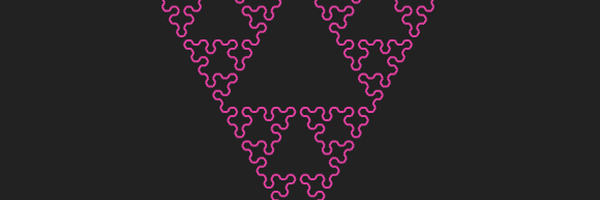
More fractals using rewriting systems
August 25, 2019I've been working through a great book called The Algorithmic Beauty of Plants.
The first chapter introduces the concept of L-systems, where complex shapes can be built up by starting with an initial shape, and replacing each part of it according to a set of rules.
These simple shapes can be created using Turtle graphics: we start with a state defined by a position and an angle, and then we can either tell the turtle to:
- Move forward
- Turn left, or
- Turn right
As the turtle moves it draws a line where it's been (it's sometimes useful to have the turtle move without drawing a line as well).
In the simple L-systems we'll cover here, we represent the commands we give the turtle using simple strings:
F: move forward.-: turn right.+: turn left.
Then we can draw our initial shape using a string like F-F-F-F, which draws a square when the turn angle is 90°. Each F moves the same distance, and each -/+ turns by the same amount.
To create fractals from using this system, we take each part of the initial string and replace it according to a set of rules, like:
{'F': 'F-F+F+FF-F-F+F'}
i.e. replacing each forward movement of the turtle with a series of smaller segments (the size of the smaller segments relative to the original is important for getting the right result, something I felt the book didn't explain well). Then you can repeat these replacements multiple times, replacing the segments with smaller and smaller copies each time.
Below, I've implemented a simple Turtle system that can understand these simple strings of commands and replacements, and I've used it to generate a few different fractals (all using the same common code with a few different settings). You can set the depth, the number of times we run the replacements, to 0 to see the initial shape.
Koch island:
- The initial shape is
F-F-F-F(a square). - The replacement rules are
{'F': 'F-F+F+FF-F-F+F'} - The turn angle is 90°
- The segment length decreases by a factor of 4 each time we replace
Koch curve:
- The initial shape is
F-F-F-F(a square again) - The replacement rules are
{'F': 'FF-F-F-F-F-F+F'} - The turn angle is 90°
- The segment length decreases by a factor of 3 each time
Sierpinski gasket:
This one requires a slight tweak to the rules: instead of just F, we have L and R: both are still just forward movements, but they can be replaced by different sequences to allow things to branch off in different directions.
- The initial shape is
R(just a line) - The replacement rules are:
{'L': 'R+L+R', 'R': 'L-R-L'} - The turn angle is 60°
- The segment length decreases by a factor of 2 each time.